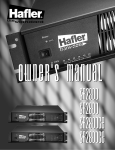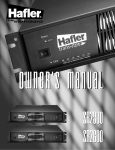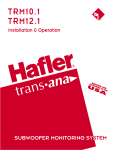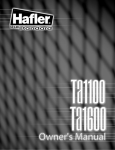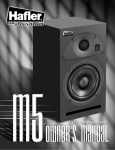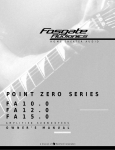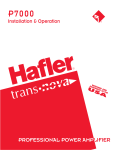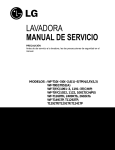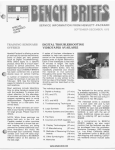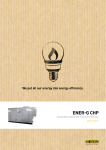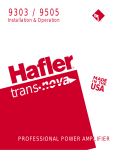Download Hafler TRM6.1 User's Manual
Transcript
Declaration of Conformity Application of Council Directive: 73/23/EEC (low voltage directive) Standard(s) to which Conformity is Declared: EN55103-1 EN55103-2 EN60065 (safety) Manufacturer’s Name: Hafler Manufacturer’s Address: 546 South Rockford Drive, Tempe, Arizona 85281, U.S.A. Importer’s Name: ________________________________________________________ Importer’s Address: ________________________________________________________ Type of Equipment: 2-channel Audio Power Amplifier/Speaker Model No.: TRM6.1 Serial Number: Year of Manufacture: 1998 1999 2000 2001 2002 I, the undersigned, hereby declare that the equipment specified above conforms to the above Directive(s) and Standard(s) Place: Hafler Date: James C. Strickland, VP Engineering 12/01/98 PERFORMANCE SPECIFICATIONS TRM6.1 Free Field Frequency Response Peak Acoustic Output Total Harmonic Distortion (THD) High Frequency Driver Low Frequency Driver Cabinet Front Panel: Rear Panel: Dimensions Net Weight AMPLIFIER SECTION Power Rating Signal-to-Noise CMRR Input Impedance Input Sensitivity Range Gain Power Consumption (both channels driven) 55Hz–21kHz, ±2dB ≥119dB (per pair w/music @ 1m) <0.5%, 150Hz–21kHz (90dB @ 1m on axis) 1" (25mm) Vifa Soft Dome 6.5" (165mm) Polypropylene Cone/ Inverted Nitrile Rubber Surround Magnetically Shielded 0.26 ft3 (7.3 liters) Vented Power Switch System LED (Power/Clip/Thermal) XLR Balanced Input RCA Unbalanced Jack Unbalanced/Balanced DIP Switch Input Sensitivity DIP Switches Bass Rolloff DIP Switches Bass Shelving DIP Switches Treble Shelving DIP Switches IEC Standard Line Input / AC Line Fuse 8.875"W x 13.25"H x 11.50"D (22.54cm x 33.65cm x 29.21cm) 23 lbs. (10.43kg) FTC (20Hz–20kHz, 0.1% THD) 35 Watts RMS @ 6 ohms (high frequency) 50 Watts RMS @ 4 ohms (low frequency) >100dB >70dB typical @ 1kHz 47kΩ per phase balanced, 47kΩ unbalanced 500mV to 3V (unbalanced) 275mV to 1.5V (per phase balanced) (+4dB, +1dB, -2dB, -5dB, -8dB, -11dB) +33dB max. to +18dB min. Idle Power: 11W / 150mA @ 115 VAC Idle Power: 11W / 75mA @ 230 VAC Normal Operation: 55W / 600mA @ 120 VAC Normal Operation: 54W / 310mA @ 230VAC Full Power: 139W / 1.37A @ 120VAC Full Power: 130W / 680mA @ 230VAC Frequency Response @ 1m on axis Energy Time Curve Horizontal Polar Response CROSSOVER SECTION Crossover Frequency Crossover Slope Subsonic Filter Bass Shelving Treble Shelving 3.2kHz 24dB/octave Linkwitz-Riley Selectable 30Hz or 60Hz @ 12dB/octave 30Hz to 200Hz, ±4dB (+4dB, +2dB, 0dB, -2dB, -4dB) 5kHz to 20kHz, ±4dB (+4dB, +2dB, 0dB, -2dB, -4dB) Dimensions Specifications are subject to change without notice. –i– NOTICE - IMPORTANT SAFETY INFORMATION CAUTION RISK OF ELECTRIC SHOCK DO NOT OPEN The lightning flash with arrowhead symbol within an equilateral triangle is intended to alert the user to the presence of uninsulated "dangerous voltage" within the product's enclosure, that may be of sufficient magnitude to constitute a risk of electric shock to persons. ! The exclamation point within an equilateral triangle is intended to alert the user of the presence of important operating and maintenance (servicing) instructions in the literature accompanying the appliance. WARNING: TO PREVENT FIRE OR SHOCK HAZARD DO NOT EXPOSE THIS EQUIPMENT TO RAIN OR MOISTURE. 1. READ INSTRUCTIONS All the safety and operating instructions of your Hafler equipment should be read before power is applied to the equipment. 2. RETAIN OWNER'S MANUAL These safety and operating instructions should be retained for future reference. 3. HEED WARNINGS All warnings on the equipment and in the operating instructions are important and should be followed. 4. FOLLOW INSTRUCTIONS All operating and use instructions are important and should be followed. 5. HEAT The equipment should be kept away from areas of high temperature, i.e., heater vents, radiators, stoves/ovens, fireplaces, etc. 13. OBJECT AND LIQUID ENTRY Care should be taken so that objects and/or liquids, such as cleaning fluids or beverages, are not spilled into the enclosure of the equipment. 6. VENTILATION The equipment should be used in an area suitable for proper ventilation. Care should be taken not to impede airflow in and around the cabinet. 14. DAMAGE REQUIRING SERVICE Hafler equipment should be serviced by qualified service personnel when: 7. WATER AND MOISTURE The equipment should not be used in or around water, such as a bathtub, sink, or swimming area. Also, the equipment should not be used in areas prone to flooding, such as a basement. A. The power supply cord or plug has been damaged, or POWER SOURCES The equipment should be connected only to a power source of the same voltage and frequency as that listed on the rear panel above the power cord entry point. C. The equipment has been exposed to rain, or POWER CORD PROTECTION Power cords should be arranged so they do not interfere with the movement of objects in the room: people, fan blades, utility carts, etc. Also, care should be taken that the cord is not pinched or cut, and placed so it is not in danger of being pinched or cut, as in under a rug, around a tight corner, etc. E. The equipment has been dropped, or the enclosure has been damaged. 8. 9. grounded connection. It is important that the blades of the equipment’s plug be able to fully insert into the mating receptacle. Never remove the round grounding pin on the plug in an attempt to mate to a two wire ungrounded receptacle: use a grounding adaptor with the grounding tab or wire suitably connected to earth ground. 11. NON-USE PERIODS During periods of extended non-use, the power cord should be unplugged from the power source. 12. CLEANING The equipment should be cleaned only as detailed in the operating instructions. B. Objects have fallen onto, or liquid has been spilled into the equipment, or D. The equipment does not appear to operate normally or exhibits a marked change in performance, or 15. SERVICING The user should not attempt to service the equipment beyond that which is described in the operating instructions. All other service should be referred to qualified service personnel. 10. POWER CORD GROUNDING The power supply cord is of a three wire grounded type, designed to reduce the risk of electric shock sustained from a live cabinet. It is assumed to be of suitable length for most uses of the equipment. The use of extension cords and power strips is discouraged unless they are of suitable rating to deliver the required total current for safe operation of all connected equipment. Furthermore, extension cords or power strips must provide the same three wire 16. CARTS AND STANDS The equipment should be used with carts or stands only of sufficient strength and stability for the use intended. An equipment and cart combination should be moved with care. Quick stops and starts, excessive force, and uneven surfaces may cause the equipment and cart combination to topple. – ii – ESPAÑOL ADVERTENCIA – INFORMACION DE SEGURIDAD IMPORTANTE El símbolo de flecha relámpago dentro de un triángulo equilátero, es para alertar al usario de la presencia de “voltajes peligrosos” no aislados en el interior del aparato, los cuales pueden ser de suficiente magnitud para constituir un riesgo de choque eléctrico a las personas. El símbolo de exclamación dentro de un triángulo equilátero, es para alertar al usuario de la presencia de instrucciones importantes de operación y mantenimiento (servicio) en la documentación que acompaña al equipo. 1. LEA LAS INSTRUCCIONES Todas las instrucciones de seguidad y operación de su equipo Hafler, deben ser leídas antes de que el equipo sea conectado dléctricamente. 2. CONSERVE EL MANUAL DEL PROPIETARIO Estas instrucciones de seguridad y operación, deben ser conservadas para futuras referencias. 3. CUADROS DE ADVERTENCIAS Todas las advertencias en el equipo y en las instrucciones de operación, son importantes y deben ser seguidas. 4. 5. 6. 7. 8. 9. SIGA LAS INSTRUCCIONES Todas las instrucciones de uso y operación son importantes y deben ser seguidas. CALOR El equipo debe ser mantenido lejos de areas de alta temperatura, como por ejemplo: ventilaciones de calentadores, radiadores, estufas/hornos, hogueras, etc. VENTILACION El equip debe ser usado en áreas con ventilación adecuada. Deben er tornadas las precauciones necesarias para no impedir el flujo de aire dentro y alrededor del aparato. AGUA Y HUMEDAD El equipo no debe ser usado en el agua ó alrededor de ésta, tales como en una bañera, tanque o áreas de nado. También, el equipo no debe ser usado en áreas propensas a inundaciones, tales como en un sótano. FUENTES DE PODER El equipo debe ser conectado a una fuente de poder del mismo voltaje y frecuencia que el indicado en el panel trasero sobre el punto de entrada del cable de corriente. PROTECCION DEL CABLE DE CORRIENTE Los cables de corriente deben ser dispuestos de forma tal que no interfieran con el movimiento de objetos en la sala: personas, aspas de ventilación, carretillas, etc. También, es necesario tener cuidado de que el cable no esté punzado o cortado, y debe estar ubicado de forma tal que esto no ocurra, como podría suceder debajo de una alfombra o al pasar el cable por una esquina aguda, etc. 10. ATERRAMIENTO DEL CABLE DE CORRIENTE El cable de corriente es del tipo aterrado de tres hilos, diseñado para reducir el riesgo de una descarga eléctrica procendent de un chasis energizado. Se asume que su longitud es suficiente para la mayoría de usos del equipo. El uso de extensiones y multi- – iii – enchufes no es recomendado, a menos que tengan el amperaje adecuado para poder suministrar la corrioente requerida pra la operación segura de todo el equipo conectado. Aun más, las extensiones deben proveer de la misma conección aterrada de tres hiles. Es importante que el enchufe se pueda introducir completamente en el receptáculo. Nunca remeva el pin de aterramiento en un intento por conectar el cable en un receptáculo de dos hilos no aterrado: use un adaptador de aterramiento que esté adecuadamente conectado a un punto de tierra. 11. PERIODOS SIN USO Durante períodos prolongados sin uso del equipo, el cable de corriente debe ser desconectado de la fuente de electrixidad. 12. LIMPIEZA El equip debe ser limpiado solo en la forma que se detalla en las instrucciones de operación. 13. INTRODUCCIÓN DE OBJETOS Y LIQUIDO Deben ser tornadas precauciones con el fin de que objetos y/ó líquidos, tales como fluidos de limpieza y gaseosas, no sean derramados dentro del chassis del aparato. 14. DAÑOS QUE REQUIEREN DE SERVICIO Los equipos Hafler deben ser llevados a servicio por personal calificado cuando: A. El cable de corriente ó el enchufe haya sido dañado, ó B. Objetos ó líquido hayan sido introducidos ó derramado en el equipo, ó C. El equipo haya sido expuesto a lluvia, ó D. El equipo aparenta no operar normalmente ó exhibe un marcado cambio en su desempeño, ó E. El equipo se ha caído, o el chassis ha sido golpeado. 15. SERVICIO El usuario no deberá intentar darle servicio al equipo más allá de lo que está descrito en el instructivo de operación. Todo lo demás, deberá ser referido a servicio por personal calificado. 16. CARRETILLAS Y SOPORTES El equipo podrá ser usado con carretillas y soportes que tengan la fortaleza y estabilidad suficiente para el uso previsto. La combinación equipo/carretilla deberá ser movida con cuidado. Rápidas paradas y arranques, excesiva fuerza y superficies imparejas, pueden causar el volcamiento del conjunto de carretilla/equipo. FRANÇAIS ATTENTION: INFORMATIONS IMPORTANTES DE SÉCURITÉ La lumière clignotante du symbole de la flêche à l'intérieur d'un triangle équilatéral, à pour objet d'alerter l'utilisateur de la présence “d'un voltage dangereux” non-isolé à l'intérieur du produit, qui pourrait être de magnitude suffisante au risque d'éléctrocution. Le point d'exclamation, à l'intériur d'un triangle équilatéral, à pour objet de prévenir l'utilisateur de l'importance des instructions de fonctionement et de maintenance, jointes à l'appareil. 1. LIRE LES INSTRUCTIONS Le mode d'emploi et les mesures de sécurité de votre équipement Hafler devraient être consultés avant sa mise en marche. 2. CONSERVER LE GUIDE DE L'UTILISATEUR Le mode e'emploi et les mesures de sécurité devraient être conservés pour des références futures. 3. 4. 5. 13. PENETRATION DES LIQUIDES Un attention particulière est éxigée quant à la dispersion de liquides tels que les produits de nettoyage et boissons, de façcon à éviter toute pénetration dans l'enceinte du matériel. SUIVRE LE MODE E'EMPLOI Le mode d'emploi et les conseils d'utilisation sont importants et devraient être suivis. 14. DÉGÂT NÉCESSITANT UNE RÉVISION Le matériel Hafler devrait être révisé par des personnes qualifées de service après-vente, lorsque: CHALEUR Le matériel devrait être préservé loin de toute source de chaleur: radiateurs, cuisinière/fours, cheminées,…etc. VENTILATION Le matériel devrait être utilisé dans un endroit à bonne ventilation. Il reste nécessaire de respecter la circulation de flux d'air à l'intérier et autour du meuble. 7. EAU ET HUMIDITÉ Le matériel ne devrait pas être utilisé près d'une source d'eau, telle qu'une baignoire, un évier, ou une aire de baignade. De plus, le matériel ne devrait pas être utilisé dans des lieux sujets aux innondations, tels que les sous-sols. 9. 12. NETTOYAGE Le matériel devrait être nettoyé en respectant les instructions indiquées. CONSIDÉRATIONS DE MISE EN GARDE Le mode d'emploi et les mises en garde concernant cet équipement sont de grande importance et devraient être suivis. 6. 8. électrique requise à un fonctionement sans risque, de tout matériel relié. 11. PÉRIODES DE NON-UTILISATON Durant les périodes de non-utilisation, la prise de courant ne devrait pas être branchée à une source d'energie. A. Les fiches ou la prise de courant ont été endommagé, ou: B. De objets sont tombés sur le matériel, ou des liquides s'y sont dispersés, ou: C. Le matériel a été exposé à la pluie, ou: D. Le matériel ne semble pas fonctioner correctement, ou affiche un changement de performance, ou: E. Le matériel a été renversé à terre, ou l'enceinte a été endommagée. SOURCES D'ÉNERGIE Le matériel devrait seulement être relié à une source d'énergie de même voltage et fréquence que celle indiquée sur le tableau arrière, au dessus de la fiche d'entrée de la prise de courant. 15. REVISION L'utilisateur ne devrait pas essayer de réviser le matériel en allant plus loin que ce qui a été décrit dans le mode d'emploi. Toute autre réviion devrait être confiée à un personnel qualifié. PROTECTION DE LA PRISE DE COURANT La prise de courant devrait être arrangée de façon à ne pas interférer avec le déplacement d'objets (chariots, pales de ventillateurs…etc.) ou de personnes à l'intérieur de la pièce. D'autre part, il faudrait faire tres attention à ce que la prise ne soit pas percée ou coupée, ou disposée de façon à risquer de l'être, comme sous un tapis, autour d'un angle pointu…etc. 16. CHARRIOTS ET MEUBLES Le matériel devriat être utilisé avec des charriots et meubles de qualité et stabilité suffisante à son utilisation préconçue. L'ensemble du matériel et du charriot devrait être déplacé avec précaution. Des mises en marche et arrêts brusques, des collisions excessives ainsi que des surfaces inégales peuvent renverser l'ensemble du matériel et du charriot. 10. PRISE DE COURANT ÀTROIS FICHES La prise de courant est composée de trois fiches, désignées à réduire le risque de décharge électrique de l'appareil. Elle devrait être de longueur suffisante pour la plupart des utilisations de ce matériel. L'utilisation de rallonge t d'adaptateur est déconsellée à moins dêtre en mesure de fournir la charge – iv – DEUTSCH ACHTUNG – WICHTIGE SICHERHEITS – INFORMATIONEN Der Blitz mit dem Pfeil, in einem gleihschenkligen Dreieck, soll den benutzer vor unisolierter “gefährlicher Spannung” innerhalb des Gerätes warnen. Das Ausrufezeichen, in einem gleichschenkligen Dreieck, soll den Benutzer darauf aufmerksam machen, daβ dem Gerät wichtige Operations - und Service - Informationen beigefügt sind. 1. INSTRUKTIONEN LESEN Alle Sicherheits- und Operationshinweise Ihres Hafler Equipments sollten vor der Inbetriebnahme gelesen werden. 11. ZEITRÄUME IN DENE DAS GERÄT NICHT GENUTZT WIRD Wird das Gerät über einen längeren Zeitraum nicht genutzt (z.B. Urlaub), ziehen Sie bitten den Netzstecker aus der Steckdose. 2. BETRIEBSANLEITUNG AUFBEWAHREN Bewahren Sie die Bedienungsanleitung sorgfältig auf, damit Sie in dieser auch in Zukunft nachschlagen können. 12. REINIGEN Reinigen Sie das Gerät nur, wie in der Bedienungsanleitung detailliert beschrieben. 3. WARNUNGEN BEACHTEN Alle Warnungen des Gerätes und der Bedienungsanleitung sind extrem wichtig und müssen befolgt werden. 13. EINDRINGEN VON FREMDKÖRPERN Achten Sie darauf, daβ weder Fremdkörper, noch Flüssigkeiten in das Gerät eindringen. 4. INSTRUKTIONEN BEACHTEN Alle Operations- und Gebrauchshinweise sind extrem wichtig und müssen beachtet werden. 14. ERFORDERLICHER REPARATURSERVICE Hafler Equipment sollte nur von qualifizierten Service-Technikern instand gesetzt werden, wenn: 5. HITZE Das Equipment sollte fern von Hitze ausstrahlenden Geräten aufgestellt werden, wie z.B. Heizungen, Öfen etc. 6. VENTILATION Das Equipment sollte so aufgestellt werden, daβ eine ausreichende Ventialition gewährt wird. 7. WASSER UND FEUCHTIGKEIT Das Equipment sollte nicht im oder in der Nähe von Wasser benutzt werden, wie z.B. in Schwimmbädem, Saunen etc. Es sollte ebenfalls nicht in Überschwämmungsgefährdeten Gebieten aufgestellt werden, wie z.B. Kellerräumen. 8. β STROMANSCHLUβ Das Equipment darf nur an eine Stromversorgung angeschlossen werden, die die gleichen Parameter aufweist, welche auf der Rückseite, über em Anschluβterminal des Gerätes, aufgelistet sind. 9. SCHUTZ DER ZULEITUNG Die Zuletungen sollten so verlegt werden, daβ diese nicht in den Bewegungsbereich anderer Möbelstücke oder Personen hereinragen. Achten Sie darauf, das das Kabel nicht gequestscht oder durchschnittren wird, wie z.B. unter Schränken oder an scharfen Kanten etc. A. Das Stromversorgungskabel beschädigt wurde B. Eine Flüssigkeit in das Gerät eingedrimgem ist C. Das Gerät Regen ausgesetzt wurde D. Das Gerät nicht mehr ordnungsgemäβ funktioniert, ggf. nicht mehr die volle Leistung abgibt E. Das Gerät runtergefallen ist oder das Gehäuse beschädigt wurde 15. SERVICE Der Benutzer sollte nur den Service ausführen, der in der Bedienungsanleitung für den Benutzer freigegeben wird. Den weiterführenden Service sollte nur von qualifizierten Tevhnikern durchgeführt werden. 16. AUFSTELLUNG Das Equipment sollte so aufgestellt werden, daβ der gewählte Untergrund die erforderliche Stabilität aufweist, so daβ eine gefahrlose Bnutzong gewährleistet wird. Das Equipment und der Untergrund sollte mit äuberster Vorsicht bewegt werden. Bei schnellen Bewegungen oder starkem Abbremsen, kann es zum Umkippen des Equipments kommen. β 10. MASSEANSCHLUβ Das dreiadrige Anschlubkabel ist mit einem Erdungsleiter ausgestattet, welcher die Risiken eines Elektroschocks verringert. Das Kabel hat eine Länge, welche für die meisten Anwendungen völlig ausreicht. Wenn Sie Verlängerungskabel benutzen, achten Sie darauf, das dies die erforderlichen Ströme bertragen können. Benutzen Sie immer dreiadrige Verlängerungskable. –v– ITALIANO NOTARE – IMPORTANTI INFORMAZIONI SULLA SICUREZZA Il simbolo del fulmine in un triangolo equilatero vuole avvertire della presenza di tensioni elevate non isolate e di valore sufficiente per costituire rischio di shock elettrico alle persone. Il punto esclamativo contentuto in un triangolo equilatero vuole avvertire l'utente della presenza di parti di servizio e di manutenzione che sono dettagliate nel manuale di istruzioni. 1. 2. LEGGETE LE ISTRUZIONI Tutte le istruzioni riguardanti la sicurezza ed il funzionamento devono essere lette prima di applicare tensione all'apparato. 11. PERIODI DI NON UTILIZZO Durante lunghi periodi di non utilizzo, staccare il cavo di alimentazione. CONSERVATE IL MANUALE Queste istruzioni riguardanti la sicurezza ed il funzionamento devono essere conservate come riferimento futuro. 12. PULIZIA L'apparato deve essere pulito solo come indicato dalle istruzioni. 3. AVVERTENZE Tutte le avvertenze poste sull'apparato e sul libretto di istruzioni sono importanti e devono essere seguite. 13. INGRESSO DI OGGETTI E LIQUIDI Si deve prestar attenzione che oggetti e liquidi, come fluidi detergenti e bibite, non vengano versati all'interno dell'apparato. 4. SEGUIRE LE ISTRUZIONI Tuttle le istruzioni operative e di funzionamento devono essere seguite. 14. RIPARAZIONI Gli apparati Hafler devono essere riparati da personale qualificato quando: 5. TEMPERATURA L'apparato deve essere mantenuto lontano da tuttle le zone ad alta temperature, termosifoni, termoconvettori, stufe e forni, caminetti ed altro. 6. 7. 8. 9. A. Il cavo di alimentazione o la spina sono danneggiati B. Oggetti sono caduti all'interno del telaio o quando del liquido è entrato VENTILAZIONE L'apparato deve essere posizionato in aree convenienti per una corretta ventilazione. Prestare attenzione che sia consentita circolazione d'aria attorno e dentro il cabinet. ACQUA E POLVERE L'apparato deve essere posizionato lontano da zone contenenti acqua, come vasche a bagno, acquari e piscine. Inoltre non deve essere impiegato in aree soggette ad allagamento, come le cantine. REQUISITI DI ALIMENTAZIONE L'apparato deve essere connesso solo ad un'alimentazione della stessa tensione e frequenza di quanto scritto sulla parte posteriore del telaio. PROTEZIONE DEL CAVO DI ALIMENTAZIONE Il cavo di alimentazione deve essere posizionato in modo di non interferire con il movimento di oggetti nella stanza: persone, ventilatori, carrelli, ecc…prestate attenzione anche che il cavo non sia tagliato o spellato e che non possa tagliarsi e spellarsi. C. Quando l'apparato è stato esposto a pioggia D. Quando l'apparato non sempra funzionare normalmente o quando esibisce un cambiamento di prestazioni o E. Quando è caduto o il telaio è stato danneggiato 15. ASSISTENZA L'utente non deve tentare di prestare assistenza all'apparato, se non per quanto esposto nelle istruzioni. Tutti gli altri interventi devono essere effettuati da un tecnico specializzato. 16. CARRELLI E STAND L'apparato deve essere impiegato su carrelli o stand solo se questi sono sufficientemente solidi e stabili per la funzione a cui si vuole dedicarli. La combinazione di carrello ed apparato deve essere mossa con cautela. Fermate e partenze improvvise, forze eccessiva e superfici irregolari, possono ribaltare la cominzione carrello e apparato. 10. MESSA A TERRA Il cavo di alimentazione è del tipo a tre fili con terra ed è progettato pr ridurre il rischio di shock elettrici. Si presume che sia della lunghezza sufficiente per la maggior parte degli impieghi. L'impiego di prolunghe e adattatori è sconsigliato se questi non garantiscono la potenza sufficiente per i corretto fuinzionamento degli apparati connessi. E altersì importante che vengano sempre impiegate prolunghe con la configurazaione a tre fili con terra. – vi – TABLE OF CONTENTS PERFORMANCE SPECIFICATIONS ........................................................................................................................i Frequency Response Graph Energy Time Curve Graph Horizontal Polar Response Graph Dimensions SAFETY PRECAUTIONS ..........................................................................................................................................ii INTRODUCTION ..................................................................................................................................................1 TECHNICAL DESIGN FEATURES ............................................................................................................................1 FRONT & REAR PANEL VIEWS ..............................................................................................................................4 INSTALLATION Location ............................................................................................................................................................5 Determining Acoustic Center ............................................................................................................................6 Input Switch ......................................................................................................................................................6 XLR Wiring Configurations ............................................................................................................................... 6 SCHEMATIC DIAGRAMS Schematic Diagram............................................................................................................................................7 PC Board Layout ..............................................................................................................................................12 OPERATION Input Sensitivity................................................................................................................................................13 Bass Roll Off ....................................................................................................................................................13 Bass Shelving ..................................................................................................................................................14 Treble Shelving ................................................................................................................................................14 AC Line............................................................................................................................................................14 Power Switch ..................................................................................................................................................14 Status LED........................................................................................................................................................15 Rubber Pad ......................................................................................................................................................15 Break-In and Warm-Up ....................................................................................................................................15 Cleaning and Maintenance ..............................................................................................................................15 SERVICE REFERENCE Parts List ..........................................................................................................................................................16 Functional Block Diagram ..............................................................................................................................19 Circuit Operation ............................................................................................................................................20 Calibration ......................................................................................................................................................20 Input Circuit ....................................................................................................................................................21 Tweeter Crossover ............................................................................................................................................21 Woofer Crossover ............................................................................................................................................22 Thermal Protection ..........................................................................................................................................22 Clipping Indicator ............................................................................................................................................23 On Indicator ....................................................................................................................................................23 Tweeter Replacement ......................................................................................................................................24 Woofer Replacement........................................................................................................................................24 Amplifier Replacement ....................................................................................................................................25 Transformer Replacement ................................................................................................................................25 WARRANTY ..........................................................................................................................................................26 INTRODUCTION Thank you and congratulations on your purchase of the HAFLER TRM6.1 reference monitor, the world's finest brand in professional audio equipment. The TRM6.1 (Trans•ana Reference Monitor) is a bi-amplified, two-way near field monitor offering unmatched quality and performance in a truly professional grade product. The TRM6.1 is great for Professional Studios, Digital Work Stations, Broadcast Booths, and Home Project Studios. Although we realize a professional such as yourself already knows a thing or two about pro audio, we urge you to read this manual to at least humor our technical writer. For ease of use, this manual is organized into three main sections: Installation, Operation, and Service Reference. “Installation” covers the set-up of your new HAFLER equipment in the system. “Operation” covers the controls and how to use them for optimum performance. “Service Reference” contains field service information useful for technicians and engineers. TECHNICAL DESIGN FEATURES The TRM6.1 amplifiers utilize our trans•ana circuit topology employing MOSFETs in the output stage resulting in superior sound quality. An active 4th order Linkwitz-Riley crossover sends frequencies above 3.2kHz to a 35-watt amplifier driving a proprietary wave guide tweeter, and frequencies below 3.2kHz to a 50-watt amplifier driving an 6" transducer. The high frequency channel features up to ±4dB of Treble shelving, while the low frequency channel features up to ±4dB of Bass shelving. In addition, the low frequency channel includes an active 2nd order subsonic filter selectable to limit harmful frequencies below 30Hz or 60Hz. Monitoring the status of both channels is done with an LED indicating Power On, Clipping and Thermal. The high frequency transducer is a Ferrofluid cooled 1" (25mm) soft dome hemispherical tweeter utilizing a rigid but lightweight silk diaphragm. A Phase Lens and axis-symmetric exponential waveguide improve the transition of soundwaves from planar to spherical which result in excellent high frequency dispersion and coherent on-axis frequency response. The low frequency transducer is a proprietary 6.5" (165mm) steel basket woofer utilizing a 20 mil polypropylene cone with a 20 mil dust cap. The suspension consists of a nitrile rubber surround and an extended collar flat spider. The motor is constructed from a 1.25" diameter voice coil on an anodized aluminum former with an extended vented pole piece. The 33 oz. ferrite magnet is magnetically shielded to suppress stray leakage flux to only 4"...well within the confines of the monitor's walls, making it great for use near CRT monitors. The cabinet is made from acoustically dead 19mm MDF, internally lined with damping material, and features a rear firing radiused Aerovent for reduced turbulence. The outside features a semi-gloss finish and includes a rubber pad on the underside to control vibration. –1– Amplifie MEHSA (Maximum Efficiency HeatSink Application) MEHSA is a proprietary process that yields up to 5 times better heat transfer than traditional FET mounting techniques using the exact same components. A multi-layer insulated metal substrate operating with minimal thermal resistance spreads heat both downward and outward to quickly dissipate heat from each device across the heatsink. This process combined with our DSM technology and MOSFET devices allow us to squeeze more watts per cubic inch from every output device as well as provide consistent thermal stability. The MEHSA Way The Old Way THE RESULT: Better reliability through faster heat dissipation. Trans•ana Trans•ana (TRANSconductance Active Nodal Amplifier) is a circuit that allows the audio signal to pass through the amplifier at low voltage. The signal is directly level-shifted to the fixed high voltage rails via a pair of driver transistors. Signal linearity is assured by an active node formed by the driver transistors at ultrasonic frequencies. This allows amplifier performance similar to Trans•nova which is highly stable and linear while utilizing the advantages of a non-floating power supply. THE RESULT: An extended frequency band width accurately supplied to the output stages of the amplifier. MOSFET Devices HAFLER is one of the few manufacturers in the sound community to utilize MOSFET devices in both the power supply and output stages. MOSFET (Metal Oxide Semiconductor Field Effect Transistor) devices offer several important inherent advantages over the 30-year-old technology of bi-polar design. These advantages include: thermal stability, fast switching speed, ultra low output impedance and wide bandwidth linearity. In addition, MOSFETs operate very similarly to vacuum tubes in that they are more linear than bipolar transistors. However, MOSFETs can deliver the midrange clarity without the limitations of transient response and high frequency phase shifting normally associated with tube operation. THE RESULT: Thermal stability, fast switching speed, ultra low output impedance and wide bandwidth linearity. –2– Tweete Wave Guide The wave guide is a proprietary axis-symmetrical form of horn mounted to the tweeter to increase efficiency. The wave guide improves the transition of sound waves (from planar to spherical) smoothly from the throat of the wave guide to the mouth. The unique shape and smooth surfaces improve the tweeter's off-axis frequency response as well as provide coherent on-axis response. THE RESULT: Improves dispersion for a wider “sweet spot.” Woofer Shielded Magnet A shielded magnet is used to reduce the radiation of high-strength magnetic fields from the woofer's motor assembly. Suppression is accomplished by attaching a “bucking” magnet to the motor assembly in order to keep stray leakage flux within the monitor cabinet. This type of shielding prevents color and image distortion when placing the woofer in close proximity to direct view (CRT) television receivers and computer monitors. THE RESULT: Prevents distortion in TV and computer monitors. Cabine Phase Coherent Each monitor is Phase Coherent in order to assure proper arrival times of all frequencies in the near field environment. This is accomplished by aligning both transducer's voice coils on a common ZDP (Zero Delay Plane) axis. The cabinet baffle positions the woofer forward and the waveguide displaces the tweeter back with an additional 39ms delay in the high frequency amplifier to precisely “tweak” the tweeter onto its ZDP axis. This allows the acoustic center, located midway between the high and low frequency transducers, to coherently deliver a flat frequency and phase response around the crossover point. THE RESULT: Delivers a flat frequency and phase response. –3– Front Panel View Rear Panel View Tweeter Wave Guide Status LED Power Switch Balanced Input Unbalanced Input Input Switch Sensitivity Bass Roll Off Bass Shelving –4– Treble Shelving Woofer Heatsink AC Line Input AC Line Fuse Rubber Pad INSTALLATION LOCATION The location of your reference monitors in addition to the acoustics of the listening room will influence the system frequency response. In the near field environment, our ears are more sensitive to direct sound rather than the reverberation of sound. Below are some recommendations for the initial set-up which may help you optimize performance in complex acoustic environments. In any configuration, keep the rear of the monitor at least 5" (12.7cm) away from any wall or obstruction to reduce excessive boundary “loading” of the woofer vent and to optimize heat sink cooling. Fig. 1 INADEQUATE Off-Axis Response Fig. 2 OPTIMUM On-Axis Response Aiming the monitors directly forward (Fig. 1) may cause response problems resulting in inadequate stereo imaging. Aiming the monitors toward you and spaced equally like a triangle (Fig. 2) provides the best imaging and produces the flattest frequency response. Fig. 3 INADEQUATE Horizontal Alignment Fig. 4 OPTIMUM Vertical Alignment If you frequently move your chair from side to side in front of your mixing console, positioning the tweeter and woofer in horizontal alignment (Fig. 3) can create complex lobing patterns. Minimizing this effect can be achieved by placing the tweeter and woofer in vertical alignment (Fig. 4). If it is essential to position the monitors horizontally, place them with the tweeters toward the inside. –5– DETERMINING ACOUSTIC CENTER Finding the “Acoustic Center” is accomplished by positioning the monitors so coherent arrival of the transducers occurs at ear level. The Acoustic Center is located 3 to 4 feet in front of the monitor, measuring perpendicularly from the center point of the cabinet (midway between the woofer and tweeter). Our tests have shown that a flat phase and frequency response occurs just above and below the Acoustic Center with the minimum and maximum height spanning between the tweeter dome and woofer dust cap. INPUT SWITCH The unbalanced input uses a conventional RCA phone jack. Move the input switch ON (-->) to use this jack. The balanced input jack is an XLR plug. The XLR jack is connected according to the IEC and AES standard. Move the input switch OFF (<--) to use this jack. Unbalanced Input Balanced Input Move input switch RIGHT (-->) to use RCA connector Move input switch LEFT (<--) to use XLR connector Use good judgement and common sense throughout all phases of the installation and use mounting techniques appropriate for the surface you select. Use the mounting hardware according to the manufacturer's recommendation and provide adequate reinforcement to the monitors if needed. Do not mount the monitor only to drywall— make sure the fasteners are secured to a stud, joist, or other structural support. If appropriate, use a secondary support for added safety—a properly installed safety cable provides an extra margin of safety and can be installed out of sight easily. MOUNTING The monitor may be mounted on a wall or ceiling, using suitable mounting hardware. The base of the monitor includes mounting inserts designed for use with “OmniMount Systems®” or equivalent mounting products1. If you mount the monitors to a wall or ceiling, you must take special care to mount them securely to prevent them from falling and causing damage or injury. Make sure that the mounting hardware (fasteners and connectors) and the surface you are mounting to are each capable of securely holding the monitor in place even if it is struck or moved. Make sure the mounting hardware, fasteners, and connectors are rated for an object at least as heavy and bulky as the monitor. OmniMount Part # 100 ST-MP / 100 STX-MP OmniMount Part # 100 WB / 100 WBX 1 “OmniMount Systems®” is a registered trademark of OmniMount Systems, 1501 West 17th Street, Tempe, Arizona 85281-6255, TEL (602) 829-8000 FAX (602) 756-9000. OmniMount Systems is not affiliated with Hafler or Rockford Corporation. XLR WIRING CONFIGURATIONS Using the balanced XLR input is recommended for installations where long cable runs are used or when the potential for stray electromagnetic fields from other wires exists. There is a balanced and unbalanced method in which the XLR inputs can be used. The first method is an XLR Balanced Input using 3-conductor cable. The balanced signals carried on pins 2 and 3 are equal in amplitude and opposite in phase. Pin 1 is the ground and shield. In this configuration, noise common on both phases of signal are effectively "canceled" out. The second method is an XLR Unbalanced Input using 2-conductor cable with the signal carried in the center conductor and the ground carried on the shield. Many popular mixers use unbalanced outputs and can be used with the XLR balanced input. However, in this type of configuration we recommend using twisted pair cable or short cable length to prevent residual ground noise. XLR Balanced Input XLR Unbalanced Input Check output from source for proper signal polarity Connect (–) and GND (shield) terminals at both ends of cable to prevent unstable amplifier operation INPUT INPUT FROM SOURCE Pin 1 = GND Pin 2 = (+) Pin 3 = (–) Pin 1 = GND Pin 2 = (+) Pin 3 = GND –6– FROM SOURCE SCHEMATIC DIAGRAM NOTES: Unless specified otherwise 1. All resistors in ohms. 2. All capacitors in microfarads. 3. Channel 1 only shown. –7– Qualified Service Personnel Only –8– SCHEMATIC DIAGRAM NOTES: Unless specified otherwise 1. All resistors in ohms. 2. All capacitors in microfarads. 3. Channel 1 only shown. –9– Qualified Service Personnel Only –10– Qualified Service Personnel Only SCHEMATIC Diagram NOTES: Unless specified otherwise 1. All resistors in ohms. 2. All capacitors in microfarads. 3. Channel 1 only shown. -11- PC BOARD LAYOUT Qualified Service Personnel Only – 12 – OPERATION NOTE: When using the INPUT SENSITIVITY, select only one switch configuration at a time. Engaging multiple switch configurations (i.e., moving two or more switches ON) may cause undesirable operation and is NOT RECOMMENDED. INPUT SENSITIVITY The Input Sensitivity adjustment is used to match the monitor with signal levels from a variety of mixing consoles. The Input Sensitivity uses DIP switches to match input levels over a 15dB range and are marked +1dB, –2dB, –5dB, –8dB, and –11dB. These numbers indicate the input in dBu required to produce an output of 100dB SPL @ 1 meter. When all switches are in the OFF (left) position, the monitor is matched to +4dB input level. In the +4dB switch setting, the monitor is less sensitive to the input signal. In the –11dB switch setting, the monitor is more sensitive to the input signal. I N P U T +4dB Input +1dB Input –2dB Input –5dB Input –8dB Input –11dB Input NOTE: When using the Bass Roll Off, select only the 30Hz or 60Hz filter. Engaging both switch configurations at one time (both switches ON) may cause undesirable operation and is NOT RECOMMENDED. BASS ROLL OFF The Bass Roll Off is a subsonic filter used to limit harmful frequencies sent to the low frequency transducer to prevent overexcursion. The filter is selectable to electronically limit frequencies below 30Hz or 60 Hz at a 12 dB/octave roll off. When both switches are in the OFF (left) position, the amplifier has an electrical -3dB down point of 28Hz. For optimum operation select only one switch configuration at a time. 30Hz Subsonic Filter 60Hz Subsonic Filter – 13 – NOTE: When using the BASS SHELVING & TREBLE SHELVING, select only one switch configuration at a time. Engaging multiple switch configurations (i.e., moving two or more switches ON) may cause undesirable operation and is NOT RECOMMENDED. BASS SHELVING Bass Shelving is used to match the low frequency response of the monitor to the acoustic environment. Bass Shelving uses DIP switches to control frequencies from 40Hz to 200Hz over an 8dB range and are marked +4dB, +2dB, –2dB, and –4dB. When all switches are in the OFF (left) position, the bass level is at 0dB. +4dB +2dB 0dB –2dB –4dB TREBLE SHELVING Treble Shelving uses DIP switches to control frequencies from 5kHz to 20kHz over an 8dB range and are marked +4dB, +2dB, –2dB, and –4dB. When all switches are in the OFF (left) position, the treble level is at 0dB. +4dB +2dB 0dB –2dB –4dB AC LINE The TRM6.1 operates from a 115 VAC/60Hz power line. The TRM6.1CE operates from a 230 VAC 50/60Hz power line. Connection is made by a 16 gauge, IEC Type 320, grounded line cord. For safety considerations only a properly grounded (earthed) receptacle should be used. If a grounded circuit is not available, do not break off the ground pin; use the proper adapter plug for a two wire receptacle with the grounding plug suitably connected to earth ground. IMPORTANT: The power line fuse is mounted on the rear panel. If this fuse blows, replace it with the same type and rating as indicated in the parts list. – 14 – only POWER SWITCH The POWER switch is located on the front panel. The LED will illuminate GREEN, indicating the respective amplifiers are on. It is possible to leave the power switch in the ON position and switch the monitor remotely through a power distribution block or switched outlet. When doing so, make sure the switch is rated for the current required by the monitor. Standard practice is to turn the amplifier on last and off first when switching components to prevent sending damaging transients to the speakers. Es costumbre encender el amplificador de último y apagarlo de primero cuando se estan encendiendo/ apagando otros equipos, para así evitar el envío de transientes dañinas a los parlantes. Il est de pratique courante de commencer par tourner l'amplificateur sur “off” et de terminer par “on,” lorsqu'il s'agit de prévenir l'envoie de passages nuisible aux haut-parleurs. Der Verstärker sollte als letztes Gerät eingeschaltet und als erstes Gerät wieder ausgeschaltet werden, um eine Beschädigung der Lautsprecher durch spannungsspitzen zu vermeiden. L'uso comune consiglia l'accensione dell'amplificatore per ultimo e lo spegnimento per primo quando si accendono i vari componenti, per evitare l'invio di transitori danneggianti agli altoparlanti. STATUS LED Amplifier operation is monitored internally and has a status LED. This indicator can be used for system troubleshooting in case of aberrant behavior. LED – Monitors the status of the amplifiers. COLOR STATUS GREEN Power on* FLASHING RED Clipping RED Thermal *Indicates the amplifier is on regardless of input signal RUBBER PAD A large rubber pad is supplied to eliminate annoying buzzes and rattles when placing the monitors on mixing consoles or similar mounting surfaces. Attach the pad to the underside of the monitor in the following manner: • Thoroughly clean area where pad will be positioned (i.e., with isopropyl alcohol) • Remove paper liner from rubber pad (avoid touching adhesive with fingers) • Position pad in desired location • Press pad firmly to insure good contact BREAK-IN and WARM-UP We recommend initially breaking in the woofer for approximately 8 hours with musical information to establish the monitor's natural bass response. To achieve the best sonic performance and image stability from the internal amplifiers, we recommend letting them warm up for 1 hour before beginning any critical listening. CLEANING and MAINTENANCE There is no requirement for regular maintenance on the electronic components of the monitor. If the cabinet or woofer becomes soiled, it can be cleaned using a damp, soft cloth. If the monitor is located in a particularly dusty environment, cleaning the inside with compressed air or vacuuming every 18 to 24 months is sufficient. – 15 – PARTS LIST DESIGNATOR VALUE ALL RESISTORS IN OHMS PART # R1 R10 R102 R103 R104 R105 R106 R107 R108 R109 R11 R110 R111 R112 R113 R114 R115 R116 R117 R118 R119 R12 R120 R121 R122 R123 R124 R125 R128 R129 R13 R130 R131 R132 R133 R134 R135 R136 R137 R138 R139 R14 R140 R141 R142 R143 R144 R145 R146 R147 R148 R15 R150 R151 R154 R156 R16 R163 R164 R165 R166 R167 R169 R17 R170 R171 R172 R173 RM/10-1001B RM/10-473B RM/4-682C RM/4-682C RV-502Q RM/10-1001B RM/10-3572B RM/10-3572B RM/10-3572B RM/10-1402B RV-202 RM/10-1402B RM/10-1402B RM/10-133B RM/10-301B RM/10-621B RM/10-100B RM/10-621B RM/4-101C RM/10-2001B RM/10-1001B RM/10-103B RM/10-9761B RM/10-2800B RM/10-100B RM/4-101C RM/10-511B RM/10-511B RM/10-7151B RM/10-7151B RM/10-473B RM/10-9763B RM/10-2002B RM/10-200B RM/10-2001B RM/10-2002B RM/10-223B RV-502Q RM/10-1001B RM/10-200B RM/10-200B RM/10-103B RM/10-2001B RM/10-200B RM1-100-012 RM/10-1001B RM/10-1071B RMP/4-3921-03 RM/10-225B RM/4-3921C RM/10-1001B RM/10-335B RM/10-101B RM/10-101B RM/10-152B RM/10-1001B RM/10-472B RM/10-1622B RM/10-1913B RM/10-000B RM/10-9091B RM/10-6491B RM/10-2001B RM/10-103B RM/10-9761B RM/10-2001B RM/10-2001B RM/10-2211B RES 1.0K OHM 1/10W 1% RES 47K OHM 1/10W 5% RES 6.8K OHM 1/4W 5% RES 6.8K OHM 1/4W 5% POT 5K 10% PIHER RES 1.0K OHM 1/10W 1% 35.7K OHM 1/10 WATT 1% 35.7K OHM 1/10 WATT 1% 35.7K OHM 1/10 WATT 1% RES 14K OHM 1/10W 1% POT 2K TRIM RES 14K OHM 1/10W 1% RES 14K OHM 1/10W 1% RES 13K OHM 1/10W 5% RES 300 OHM 1/10W 5% RES 620 OHM 1/10W 5% RES 10 OHM 1/10W 5% RES 620 OHM 1/10W 5% RES 100 OHM 1/4W 5% RES 2.0K OHM 1/10W 1% RES 1.0K OHM 1/10W 1% RES 10K OHM 1/10W 5% RES 9.76K OHM 1/10W 1% RES 280 OHM 1/10W 1% RES 10 OHM 1/10W 5% RES 100 OHM 1/4W 5% RES 510 OHM 1/10W 5% RES 510 OHM 1/10W 5% RES 7.15K OHM 1/10W 1% RES 7.15K OHM 1/10W 1% RES 47K OHM 1/10W 5% RES 976K OHM 1/10W 1% RES 20.0K OHM 1/10W 1% RES 20 OHM 1/10W 5% RES 2.0K OHM 1/10W 1% RES 20.0K OHM 1/10W 1% RES 22K OHM 1/10W 5% POT 5K 10% RES 1.0K OHM 1/10W 1% RES 20 OHM 1/10W 5% RES 20 OHM 1/10W 5% RES 10K OHM 1/10W 5% RES 2.0K OHM 1/10W 1% RES 20 OHM 1/10W 5% RES 10 OHM 1W RES 1.0K OHM 1/10W 1% RES 1.07K OHM 1/10W 1% RES 3.92K OHM 1/4W 1% RES 2.2M OHM 1/10W 5% RES 3.92K OHM 1/4W 1% RES 1.0K OHM 1/10W 1% RES 3.3M OHM 1/10W 5% RES 100 OHM 1/10W 5% RES 100 OHM 1/10W 5% RES 1.5K OHM 1/10W 5% RES 1.0K OHM 1/10W 1% RES 4.7K OHM 1/10W 5% RES 16.2K 1/10 1% RES 191K OHM 1/10W 1% RES 0 OHM 1/10W RES 9.09KOHM 1/10W 1% RES 6.49K OHM 1/10W 1% RES 2.0K OHM 1/10W 1% RES 10K OHM 1/10W 5% RES 9.76K OHM 1/10W 1% RES 2.0K OHM 1/10W 1% RES 2.0K OHM 1/10W 1% RES 2.21K OHM 1/10W 1% R174 R175 R176 R177 R178 R179 R18 R180 R181 R182 R183 R184 R19 R2 R20 R21 R22 R23 R24 R25 R26 R27 R278 R279 R28 R29 R3 R30 R31 R32 R33 R34 R35 R36 R37 R38 R39 R4 R40 R41 R42 R43 R44 R45 R46 R47 R48 R49 R5 R50 R51 R52 R53 R54 R55 R56 R57 R58 R59 R6 R60 R61 R62 R63 R64 R65 R66 R67 R68 R69 R7 – 16 – RES 1.33K OHM 1/4W 1% 35.7K OHM 1/10 WATT 1% RES 909 OHM 1/10W 1% 35.7K OHM 1/10 WATT 1% 30.1K RES 1% 0805 RES 2.0K OHM 1/10W 1% RES 100K OHM 1/10W 5% RES 20 OHM 1/10W 5% RES 20 OHM 1/10W 5% RES 20 OHM 1/10W 5% RES 20 OHM 1/10W 5% RES 10 OHM 1W RES 604K OHM 1/10W 1% RES 1.0K OHM 1/10W 1% RES 100K OHM 1/10W 5% RES 2.2M OHM 1/10W 5% RES 100K OHM 1/10W 5% RES 100K OHM 1/10W 5% RES 10K OHM 1/10W 5% RES 2.0K OHM 1/10W 1% RES 1M OHM 1/10W 5% RES 1.3K OHM 1/10W 5% RES 510 OHM 1/10W 5% RES 510 OHM 1/10W 5% RES 1.3K OHM 1/10W 5% RES 121 OHM 1/4W 1% RES 1.0K OHM 1/10W 1% RES 121 OHM 1/4W 1% RES 220 OHM 1/10W 5% RES 10 OHM 1/10W 5% RES 300 OHM 1/10W 5% RES 300 OHM 1/10W 5% RES 2.0K OHM 1/10W 1% RES 3.3M OHM 1/10W 5% RES 10 OHM 1/10W 5% RES 300 OHM 1/10W 5% RES 300 OHM 1/10W 5% RES 47K OHM 1/10W 5% RES 2.0K OHM 1/10W 1% RES 620 OHM 1/10W 5% RES 300 OHM 1/10W 5% RES 1.0K OHM 1/10W 1% 24.9K OHM RES. 1/10 W 1% RES 1.0K OHM 1/10W 1% RES 3.92K OHM 1/4W 1% RES 2.2M OHM 1/10W 5% RES 3.92K OHM 1/4W 1% RES 604K OHM 1/10W 1% RES 1.0K OHM 1/10W 1% RES 4.7K OHM 1/10W 5% RES 15K OHM 1/10W 5% RES 1.0K OHM 1/10W 1% RES 2.2M OHM 1/10W 5% RES 300 OHM 1/10W 5% RES 100 OHM 1/10W 5% RES 15K OHM 1/10W 5% RES 10K OHM 1/10W 5% 200 TRIM POT 35.7K OHM 1/10 WATT 1% RES 1.0K OHM 1/10W 1% RES 100 OHM 1/10W 5% RES 10K OHM 1/10W 5% RES 2.2M OHM 1/10W 5% RES 470 OHM 1/10W 5% RES 300 OHM 1/10W 5% RES 1.5K OHM 1/10W 5% RES 620 OHM 1/10W 5% RES 1.0K OHM 1/10W 1% RES 100 OHM 1/4W 5% RES 2.0K OHM 1/10W 1% RES 1.0K OHM 1/10W 1% RM/4-1331C RM/10-3572B RM/10-9090B RM/10-3572B RM/10-3012B RM/10-2001B RM/10-104B RM/10-200B RM/10-200B RM/10-200B RM/10-200B RM1-100-012 RM/10-6043B RM/10-1001B RM/10-104B RM/10-225B RM/10-104B RM/10-104B RM/10-103B RM/10-2001B RM/10-105B RM/10-132B RM/10-511B RM/10-511B RM/10-132B RM/4-1210C RM/10-1001B RM/4-1210C RM/10-221B RM/10-100B RM/10-301B RM/10-301B RM/10-2001B RM/10-335B RM/10-100B RM/10-301B RM/10-301B RM/10-473B RM/10-2001B RM/10-621B RM/10-301B RM/10-1001B RM/10-2492B RM/10-1001B RMP/4-3921-03 RM/10-225B RM/4-3921C RM/10-6043B RM/10-1001B RM/10-472B RM/10-153B RM/10-1001B RM/10-225B RM/10-301B RM/10-101B RM/10-153B RM/10-103B RVH-201 RM/10-3572B RM/10-1001B RM/10-101B RM/10-103B RM/10-225B RM/10-471B RM/10-301B RM/10-152B RM/10-621B RM/10-1001B RM/4-101C RM/10-2001B RM/10-1001B R70 R71 R72 R73 R74 R75 R76 R78 R79 R8 R80 R81 R82 R84 R85 R86 R87 R88 R89 R9 R90 R91 R92 R93 R94 R95 R96 R97 R98 R99 RES 280 OHM 1/10W 1% RES 10 OHM 1/10W 5% RES 100 OHM 1/4W 5% RES 2.21K OHM 1/10W 1% RES 2.21K OHM 1/10W 1% RES 100K OHM 1/10W 5% 619K OHM 1/10W 1% RES 1M OHM 1/10W 5% RES 1M OHM 1/10W 5% POT 2K TRIM RES 6.49K OHM 1/10W 1% RES 6.49K OHM 1/10W 1% 46.4K OHM RES. 1/10 W 1% RES 120 OHM 1/10W 5% 46.4K OHM RES. 1/10 W 1% RES 5.49K OHM 1/10W 1% RES 1.62K OHM 1/4W 1% RES 2.0K OHM 1/10W 1% RES 2.21K OHM 1/10W 1% POT 2K TRIM RES 2.21K OHM 1/10W 1% RES 9.09KOHM 1/10W 1% RES 9.09KOHM 1/10W 1% RES 3.32K OHM 1/10W 1% RES 2.0K OHM 1/10W 1% RES 3.24K OHM 1/10W 1% RES 1.62K OHM 1/4W 1% RES 1.33K OHM 1/4W 1% 24.9K OHM RES. 1/10 W 1% RES 1.0K OHM 1/10W 1% RM/10-2800B RM/10-100B RM/4-101C RM/10-2211B RM/10-2211B RM/10-104B RM/10-6193B RM/10-105B RM/10-105B RV-202 RM/10-6491B RM/10-6491B RM/10-4642B RM/10-121B RM/10-4642B RM/10-5491B RM/4-1621C RM/10-2001B RM/10-2211B RV-202 RM/10-2211B RM/10-9091B RM/10-9091B RM/10-3321B RM/10-2001B RM/10-3241B RM/4-1621C RM/4-1331C RM/10-2492B RM/10-1001B C1 C10 C11 C12 C14 C15 C16 C17 C18 C19 C2 C20 C202 C21 C22 C23 C24 C25 C26 C27 C28 C29 C3 C30 C31 C32 C34 C35 C36 C38 C39 C4 C40 C41 C42 C43 C44 C45 C46 C47 C48 C49 C5 CAP 220PF 50V 5% CAP 47PF 50V 5% CAP 10UF 16V CAP 3300UF 35V CAP .47UF 50V CAP .1UF 50V CAP 3300UF 35V CAP .1UF 50V 10% CAP .1UF 50V 10% CAP .1UF 50V 10% CAP 220PF 50V 5% CAP .1UF 50V 10% CAP 100PF 50V 5% CAP 47PF 50V 5% CAP .47UF 50V CAP .47UF 50V CAP .1UF 50V 10% CAP .1UF 50V 10% CAP .1UF 50V CAP .1UF 50V 10% CAP 2.2UF 50V CAP 10UF 16V CAP .1UF 50V 10% CAP .1UF 50V 10% CAP .1UF 50V 10% CAP 10UF 16V CAP .1UF 50V CAP 100PF 50V 5% CAP .0022UF 50V CAP 47PF 50V 5% CAP 47PF 50V 5% CAP .1UF 50V 10% CAP .001UF 50V CAP .001UF 50V CAP .001UF 50V CAP .001UF 50V CAP 220PF 50V 5% CAP .01UF 50V CAP .01UF 50V CAP .001UF 50V CAP .001UF 50V CAP 220PF 50V 5% .047UF 50V CDS-221CAAA CDS-470CAAA CER-106SM CERS-338B CYV-474-033 CYV-104-033 CERS-338B CDS-104CBBB CDS-104CBBB CDS-104CBBB CDS-221CAAA CDS-104CBBB CDS-101CAAA CDS-470CAAA CYV-474-033 CYV-474-033 CDS-104CBBB CDS-104CBBB CYV-104-033 CDS-104CBBB CER-225CSM CER-106SM CDS-104CBBB CDS-104CBBB CDS-104CBBB CER-106SM CYV-104-033 CDS-101CAAA CYV-222-033 CDS-470CAAA CDS-470CAAA CDS-104CBBB CYV-102-033 CYV-102-033 CYV-102-033 CYV-102-033 CDS-221CAAA CYV-103-033 CYV-103-033 CYV-102-033 CYV-102-033 CDS-221CAAA CYV-473-033 C50 C51 C52 C53 C54 C55 C56 C57 C58 C59 C6 C60 C61 C62 C63 C64 C65 C66 C67 C69 C7 C70 C71 C72 C75 C76 C80 C81 C82 C83 C84 C85 C86 C87 C88 C9 CAP .001UF .047UF 50V CAP 120PF CAP .1UF 50V CAP 47PF 50V 5% CAP .001UF 50V CAP .001UF 50V CAP .1UF 50V 10% CAP .1UF 50V 10% CAP 47PF 50V 5% CAP 220PF 50V 5% CAP .001UF 50V CAP .001UF 50V CAP-022UF 50V CAP-022UF 50V CAP .0022UF 50V CAP 220PF 50V 5% CAP 120PF 50V 5% CAP .1UF 50V CAP 47PF 50V 5% CAP 220PF 50V 5% CAP 10UF 16V CAP 3300UF 35V CAP 3300UF 35V CAP 47PF 50V 5% CAP .47UF 50V CAP .1UF 50V 10% CAP .1UF 50V 10% CAP .1UF 50V 10% CAP 47PF 50V 5% CAP .1UF 50V 10% CAP .1UF 50V CAP 220PF 50V 5% CAP 120PF 50V 5% CAP 120PF 50V 5% CAP .1UF 50V 10% CDS-102CBAA CYV-473-033 CDS-121CAAA CYV-104-033 CDS-470CAAA CYV-102-033 CYV-102-033 CDS-104CBBB CDS-104CBBB CDS-470CAAA CDS-221CAAA CYV-102-033 CYV-102-033 CYV-223-033 CYV-223-033 CYV-222-033 CDS-221CAAA CDS-121CAAA CYV-104-033 CDS-470CAAA CDS-221CAAA CER-106SM CERS-338B CERS-338B CDS-470CAAA CYV-474-033 CDS-104CBBB CDS-104CBBB CDS-104CBBB CDS-470CAAA CDS-104CBBB CYV-104-033 CDS-221CAAA CDS-121CAAA CDS-121CAAA CDS-104CBBB CR1 CR10 CR11 CR13 CR14 CR15 CR16 CR2 CR22 CR3 CR4 CR5 CR6 CR7 CR8 CR9 DIO DUAL BAV99L BRIDGE RECTIFIER DIO DUAL BAV99L DIO MMBD914L DIO ZENER MMBZ5240BL DIO DUAL BAV99L DIO DUAL BAV99L DIO DUAL BAV99L DIO MMBD914L RD/GRN BICOLOR LED DIO DUAL BAV99L DIO MMBD914L DIO MMBD914L DIO MMBD914L DIO MMBD914L DIO DUAL BAV99L SS-260SM SS-0799-068 SS-260SM SS-803SM SS-1052 SS-260SM SS-260SM SS-260SM SS-803SM SS-2423 SS-260SM SS-803SM SS-803SM SS-803SM SS-803SM SS-260SM Q10 Q11 Q12 Q13 Q14 Q15 Q16 Q17 Q18 Q19 Q2 Q21 Q22 Q23 Q24 Q25 Q26 Q27 Q28 Q29 XSTR MMBT3906LT1 PNP XSTR MMBT5088L NPN XSTR MMBT5088L NPN XSTR MPS-A56 XSTR MMBT5088L NPN XSTR NPN MPSA06 XSTR MMBT5088L NPN XSTR MMBT5088L NPN XSTR MMBT5087L PNP XSTR MMBT3906LT1 PNP Regulator LM317 XSTR MMBTA06L XSTR MPS-A56R XSTR NPN MPSA06 XSTR MMBT3904LT1 NPN XSTR MMBT5088L NPN XSTR MMBT5087L PNP XSTR MMBT5088L NPN XSTR MMBT5088L NPN XSTR MPS6521 SS-0791 SS-0114 SS-0114 SS-101A-45 SS-0114 SS-102A-45 SS-0114 SS-0114 SS-0115 SS-0791 SS-1375 SS-102SM SS-101A-45 SS-102A-45 SS-0792 SS-0114 SS-0115 SS-0114 SS-0114 SS-209 – 17 – Q3 Q30 Q31 Q32 Q33 Q35 Q37 Q38 Q39 Q5 Q6 Q7 Q8 Regulator LM337 XSTR MMBT5088L NPN XSTR MMBT5088L NPN XSTR MMBT3906LT1 PNP XSTR MMBT3906LT1 PNP XSTR MMBT3906LT1 PNP XSTR MPS6521 XSTR MMBT3906LT1 PNP XSTR MMBT3906LT1 PNP XSTR MMBTA06L XSTR MMBT3906LT1 PNP XSTR MMBT3906LT1 PNP XSTR MMBT3904LT1 NPN SS-1376 SS-0114 SS-0114 SS-0791 SS-0791 SS-0791 SS-209 SS-0791 SS-0791 SS-102SM SS-0791 SS-0791 SS-0792 U1 U112 U2 U3 U4 U5 U7 U8 OPAMP TL072CD OPAMP TL072CD OPAMP TL072CD OPAMP TL072CD OPAMP TL072CD COMPTR QUAD LM339 OPAMP TL072CD OPAMP TL072CD SS-143SM SS-143SM SS-143SM SS-143SM SS-143SM SS-730SM SS-143SM SS-143SM DS1 DS12 DS4 DS8 SW SW SW SW SW-1649 SW-1649 SW-1649 SW-1649 J1 J2 JW1 JW1 CONN XLR NEUTRIK NC3FAH-2-0 RCA JACK, SINGLE WHITE, GOLD SH 2X3 JUMPER HDR 6 PIN DUAL ROW V120 VV120 RES 0 OHM 1/4W (JUMPER WIRE) RMP/4-0000-03 RES 0 OHM 1/4W (JUMPER WIRE) RMP/4-0000-03 AC6 CHASS1 TS1 SIDE ACT SIDE ACT SIDE ACT SIDE ACT DIP 4 DIP 4 DIP 4 DIP 4 POS POS POS POS Los componentes marcados con el simbolo son imprescindibles para la protección del equipo, por lo cual que solo sean reemplazados por los mismos componentes. Les componsants marqués du symbole sont indispensables à la sécuritée et ne peuvent être remplacés qu'avec des composants identiques. Bauteile, die mit einem gekenzeichnet sind, sind sehr wichtig und dürfen nur mit den orginal Ersatzteilen ausgetauscht werden. I componenti contrassegnati da sono critici per la sicurezza e devono essere rimpiazzati solo con ricambi di valore identico. CC-2339 CCH-232 CC-648 CC-673 6.5" Woofer 1" Tweeter TRM6 MEHSA Bar FG26387WP SPK10424 WP-2439 CONN IEC POWER INLET HARNESS P1000 CHASSIS GND FUSE 3A 3AG SLO BLO FUSE HOLDER CAP 3AG FUSE HOLDER BODY PC MOUNT THERMISTOR 10K EPOXY Power Switch IEC Linecord Transformer CC-1174 FA-1401-A FS-003SB FS-1175 FS-1176 SS-0426-066 SHW9840 WIR9856 TT-2326-E MODEL: TRM6.1CE Components marked with this symbol are safety critical and should only be replaced with identical components. (230 VAC 50/60 Hz) RES 0 OHM 1/4W (JUMPER WIRE) FUSEHOLDER CAP 5X20mm 5X20mm 0.8A SLO-BLO FUSE European Linecord <HAR> RMP/4-0000-03 FS-1269-A FS-1484-A WIR10138 – 18 – TRM6.1 FUNCTIONAL BLOCK DIAGRAM – 19 – SERVICE REFERENCE CIRCUIT OPERATION Qualified Service Personnel Only trans•ana Implementation The transistor Q24 is configured to operate as a switch that controls the constant current source Q21 of the differential amplifier Q27 and Q28. Switch Q24 is under the control of the thermal and turn-on circuits, and provides a Soft Start turn-on ramp according to the charging time of C70 through R13 and R156. U8B is configured as a DC servo-integrator to null the output offset voltage. Class AB bias current is established by Q29, and adjusted by R11. The positive and negative input signals are conveyed to the pre-driver transistors Q25 and Q26 by the differential amplifier Q27 and Q28, and by current mirror Q10 and Q19. Drivers Q22 and Q23 make the transition from the low-voltage front-end circuit to the high-voltage output stage. Buffer transistors Q30 and Q32 enhance the front-end drive current, and drive the positive output MOSFET Q20. The same is true for buffer transistors Q31 and Q33 and negative output MOSFET Q4. CALIBRATION WARNING: Only a competent technician should attempt the following procedure. Bias: The bias control establishes the quiescent Class AB output current of the amplifier. The bias should not need readjustment from the factory setting: however, if the amplifier is repaired and the output devices have been changed, calibrating the bias is necessary. Disconnect the power to the amplifier before removing the heatsink assembly from the speaker cabinet. To adjust the bias, remove the jumper JW1 and connect an ammeter across the exposed pins. Adjust trimpots R11 and R9 fully counter-clockwise before reapplying power to the unit. After the Soft Start turn-on has settled, note the ammeter reading. Adjust R11 until an additional 50mA is created. Then adjust R9 until another 50mA is added to the ammeter reading. Replace jumper JW1. – 20– Input Circuit Qualified Service Personnel Only The input signal is connected to the amplifier through the balanced XLR connector J1, or the unbalanced RCA connector J2. Balanced/unbalanced switch DS1 will ground the inverting input buffer, allowing operation with an unbalanced signal on either connector. Input buffers U1A and U1B provide a stable input impedance, dominated by R10 and R4. The input circuit gain is set by switches DS2-DS6. Each switch inserts a different divider resistor for the feedback resistors R88 and R169, resulting in up to 15dB of additional input gain when DS6 is closed. Trimpot R8 adjusts the common-mode-rejection of the woofer channel. The non-inverting input signal from U1A pin 1, and the inverting input signal from U1B pin 7, are summed together to form an unbalanced signal at U4A pin 1. Tweeter Crossover The balanced input signal at U1A pin 1 and U1B pin 7 connects to a 2-stage 39µs delay, using U3A and U3B. This is followed by the high-frequency shelf circuit at U7B. Switches DS13-DS16 add various reactive components to the feedback network of U7B, resulting in +4dB, +2dB, -2dB, or -4dB of gain shelving above 5kHz. The next stage at U7A is a 3.2kHz 2nd order high-pass filter. The last stage consists of another 3.2kHz 2nd order high-pass filter, bringing the overall tweeter crossover response to a 4th order 24dB/octave slope. The final components before the tweeter amplifier (R104 and R105 ) can provide up to 2dB of additional gain to the tweeter channel. – 21 – Qualified Service Personnel Only Woofer Crossover The input signal at U4A pin 1 connects to the 3200Hz 2nd order low-pass filter at U112B. Approximately 2dB of additional gain can be added to this stage by adjusting R136 against the divider resistor, R137. The next stage is a 30Hz–60Hz switchable sub-sonic high-pass filter. This is followed by an adjustable low-frequency shelving filter which defaults at +6dB gain, according to the feedback resistors R129 and R134, and dividers R131 and R128. DS9–DS12 will switch in various reactive feedback networks to accomplish +4dB, +2dB, -2dB, or -4dB of gain shelving below 200Hz. The last stage is another 3200Hz 2nd order low-pass filter at U2A, which cascades with the previous filter at U112B to produce an overall 4th order slope of 24dB/octave for the woofer amplifier. Thermal Protection The thermal protection is activated, and shuts down audio operation, when the amplifier heatsink reaches an excessively high temperature. The voltage divider R22 and R23 establishes the reference voltage on pin 5 of U5B. The control voltage on pin 4 is established by the voltage divider TS1 and R25. TS1 is a NTC (Negative Temperature Coefficient) thermistor mounted on the heatsink. As TS1 warms and the resistance falls, the voltage on pin 4 rises. When the voltage on pin 4 exceeds the voltage on pin 5, the output on pin 2 goes low, shutting down the Soft Start switches Q8 and Q24, and lighting the CLIP/THERMAL indicator red. – 22 – Qualified Service Personnel Only Clipping Indicator The CLIP indicators are driven by the comparator U5A and U5D. The voltage divider R56, R57, and R51, R61 establishes the reference voltage for the Clipping detector at pin 7 of U5A and pin 9 of U5D. Excessive drive signal at pin 6 or pin 8 will trigger its comparator low and light the CLIP/THERMAL indicator red. On Indicator The bicolor LED, CR3, will remain green unless a THERMAL or CLIP condition is detected. The outputs of comparators U5A and U5D will be high, and Q35 will be off, allowing current to flow through the green LED of CR3 from ground to –17V. – 23 – Qualified Service Personnel Only TWEETER REPLACEMENT 1. 2. 3. 4. 5. 6. 7. 8. 9. Remove (4) screws from wave guide using a 3/32" Allen Wrench Remove wave guide assembly from enclosure Disconnect the LED harness (FIG. 1) Disconnect the (2) speaker wires from the tweeter (FIG. 2) Disconnect the (2) power switch wires (FIG. 3) Unclip the tweeter from wave guide (4 catch fingers) Position the replacement tweeter into wave guide Snap the tweeter into wave guide Follow steps 1-5 in reverse order to install wave guide assembly CAUTION: Reconnect wires as indicated in each diagram! Wave Guide Assembly FIG. 1 FIG. 2 FIG. 3 LED Harness Tweeter Replacement #SPK10424 Power Switch WOOFER REPLACEMENT 1. 2. 3. 4. Remove (4) screws from woofer using a 3/32" Allen Wrench Remove woofer from enclosure Disconnect (2) speaker wires (FIG. 4) Follow steps 1-3 in reverse order to install new woofer CAUTION: Reconnect wires as indicated in each diagram! FIG. 4 Woofer Replacement – 24 – Qualified Service Personnel Only AMPLIFIER REPLACEMENT 1. Remove (2) screws from back using a 3/32" Allen Wrench (FIG. 5) 2. Disconnect PCB mounted LED harness (FIG. 6) 3. Disconnect PCB mounted tweeter speaker wires (FIG. 7) 4. Disconnect PCB mounted woofer speaker wires (FIG. 7) 5. Disconnect PCB mounted transformer primary wires (FIG. 8) 6. Disconnect PCB mounted transformer secondary wires (FIG. 8) 7. Disconnect PCB mounted power switch wires (FIG. 8) CAUTION: Reconnect wires as indicated in diagram! Remove only these (2) screws FIG. 5 Amplifier Replacement FIG. 6 PCB Mounted LED Harness FIG. 7 FIG. 8 PCB Mounted Speaker Wires Transformer / Power Switch Wires TRANSFORMER REPLACEMENT The TRM6.1 is available both 120V and 230V versions. If it is necessary to perform service on the amplifier, be sure to check connections to the transformer before re-applying power and/or reassembling the unit. CAUTION: Reconnect wires as indicated in diagram! MODEL TRM6.1 MODEL TRM6.1CE 120V 50Hz VAC 230V 50/60Hz VAC – 25 – SERVICE POLICY AND LIMITED WARRANTY Rockford Corporation (Hafler Division) offers a limited warranty on Hafler products on the following terms: • Length of Warranty 1 year on Reference Monitors • What is Covered This warranty applies only to products sold to the original owner and is non-transferable. This warranty only applies to units sold in the continental United States. You are required to have a copy of the receipt stating the customer's name, dealer name, product purchased and date of purchase. • Products found to be defective during the warranty period will be repaired or replaced (with product deemed to be equivalent) at Hafler's discretion. • What is NOT Covered 1. Damage caused by accident, abuse, improper operations, water, theft 2. Service performed by anyone other than Hafler or an Authorized Hafler service center 3. Any product purchased outside the United States (please contact your local dealer) 4. Shipping charges to get the unit to Hafler 5. Any product which has had the serial number defaced, altered, or removed • Limit on Implied Warranties Any implied warranties including warranties of fitness for use and merchantability are limited in duration to the period of the express warranty set forth above. Some states do not allow limitations on the length of an implied warranty, so this limitation may not apply. No person is authorized to assume for Hafler any other liability in connection with the sale of the product. • How to obtain service or technical support Please call 1-800-669-9899 for Rockford/Hafler support. You must obtain an RA # (return authorization number) to return any products to Hafler. You are responsible for shipment of product to Hafler. Rockford Corporation Hafler Division 2055 E. 5th Street Tempe, Arizona 85281 – 26 – HAFLER A DIVISION OF ROCKFORD CORPORATION 546 SOUTH ROCKFORD DRIVE TEMPE, ARIZONA 85281 U.S.A. 1.866.GOHAFLER 480.967.3565 WWW.HAFLER.COM MADE IN THE USA This product is designed, developed and assembled in the USA by a dedicated group of American workers. The majority of the components used in the construction of this product are produced by American companies. However, due to the global nature of their manufacturing facilities and the electronics parts industry in general, some parts may be manufactured in other countries. LIT 11382 11/00 E.W.R.




































